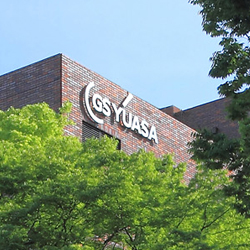A storage battery system manufactured and sold by GS Yuasa Corporation (Tokyo Stock Exchange: 6674; “GS Yuasa”) has been adopted for the new EV-E301 series (nicknamed “Accum”) developed by East Japan Railway Company (Tokyo Stock Exchange: 9020; “JR East”).
This storage battery system has been developed as a high capacity system for industrial use including the railroad industry (such as railway cars without overhead wiring, power storage systems for railway operations, and diesel hybrid cars). The system utilizes the industrial-use lithium-ion battery module LIM30H-8A which already has an abundant track record in delivery. It is an optimal system for railroad use in terms of heat radiation and charge-discharge control.
Since March 15, 2014, Accum has operated on the JR East Tohoku Main Line and Karasuyama Line between Utsunomiya and Karasuyama, and it has been powered by battery drive on the non-electrified section between Hoshakuji and Karasuyama. On the electrified section between Utsunomiya and Hoshakuji, the train is powered by electricity from overhead electric lines while charging its storage battery, whereas on the non-electrified section between Hoshakuji and Karasuyama the storage battery is charged by charging facilities when stopping at each station. Furthermore, the battery effectively absorbs and uses the electricity generated by the regenerative brakes in both the electrified section and non-electrified section, making it an environmentally-friendly system.
GS Yuasa's industrial-use lithium-ion batteries have already been practically applied in special uses such as aviation and space stations, as well as industrial uses including automated guided vehicles and power storage systems. GS Yuasa will work towards developing automotive batteries for electric and hybrid vehicles with growing demand while working to gradually increase applications in industrial fields in order to contribute to the reduction of our society's burden on the environment.
[Features of LIM30H-8A]
1. Outstanding high charge-discharge current performance
Achieves stable charge-discharge performance with a maximum current capacity of 600A and continuous energizing current of 100A.
2. Achieves longevity by reducing internal resistance
3. Light and compact
Achieves a light and compact form by using plastic resins for outer module casing. The product can be also used under high voltage as a result of the superior insulation properties of plastic resins.
4. Forced-air cooling also supported
Efficient cooling is made possible through the introduction of cooling air in the module body.
5. Standardly equipped with a battery-monitoring system that constantly monitor battery conditions
The system is standardly equipped with a battery-monitoring system that has been used with conventional industrial-use lithium-ion batteries. The system constantly monitors the voltage of all cells and the module temperature, and also has a function for sending battery data to chargers and systems.
Furthermore, external data output is made possible by mounting GS Yuasa's BMU (battery management unit).
| External dimensions (mm) | W:231 x D:389 x H:147 | Weight (kg) | Approximately 20 |
|---|---|---|---|
| Nominal voltage (V) | 28.8 | Nominal voltage (V) per cell | 3.6 |
| Nominal capacity (Ah) | 30 | Operating voltage range(V) | 23.2~33.2 |
| Maximum current capacity (A) | 600 | Continuous energizing current (A) | 100 |
| Operating temperature limit (°C) | 0-45 | Monitoring system | Voltage monitoring for all cells Module temperature monitoring |
| Structure | LIM30H-8A,22 units connected in series/10 units connected in parallel |
|---|---|
| Amount of electricity (kWh) | 190 |
| Nominal voltage (V) | 633.6 |
■1. Industrial-use lithium-ion battery module LIM30H-8A

■2. New EV-E301 Series (nicknamed “Accum”) developed by East Japan Railway Company






